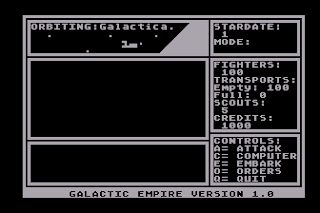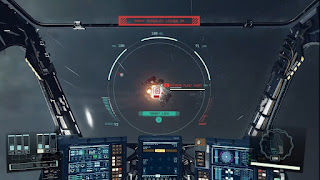SPACE "RPG" GAMES 70-79
Fuente: Mobygames
🚀1974
01🧭Star Trader
🕹Star Trader is a futuristic mercantile simulation written for the HP 2000F.🕹In the year 2070 the player must travel between colonized worlds with different levels of development to buy and sell goods with the aim of turning a profit.🕹The player must haggle for the best prices.
🕹The galaxy slowly evolves as colonies grow more sophisticated and supply and demand of goods changes.🕹Money can be put in the bank where the player can gain interest, but not all planets have banks to withdraw from.🕹The game features a world map of 10 by 10 light-years, centred around Sol.
🕹The planets further away have more raw resources and those closer by produce more advanced goods, but rely on raw resources, which is where the player comes in.
🚀1978
01🧭Space
🕹Space I is a futuristic role-playing game unofficially based upon Game Designer Workshop’s "Traveller" pen and paper game.
🕹Players build their character by enlisting in one of the military services (Navy, Army, Scouts, Merchant Marines, or Other Services) and receive training in a number of skills that will help in later life.
🕹After each round of four-year service, your character may leave the military to embark on one of six scenarios:
🎲Defend, in which as an administrator for a far-flung planet, you must defend it from an alien invasion🎲High Finance, in which can dabble in the galactic stock market🎲Explore, in which you mine planets for their riches🎲Trade; in which you earn money by transporting passengers and cargo on your spaceship🎲 First Blood; in which you pit your dexterity, cunning and weapons against an adversary in a death match to collect all his possessions.
🚀1979
01🧭Galactic Empire
🕹Galactic Empire is the first game in what was to become the Galactic Saga. It is an early example of the space empire game, later to be refined into the 4X genre.
🕹The player takes the role of the commander of the flagship of the planet Galactica. The mission is nothing less than universal conquest: the entirety of the Central Galactic System (consisting of 20 planets laid out in a three-dimensional map) will have to be conquered and held within a time limit of 1000 years.
🕹Each planet has different ratings in technological sophistication and population size.
🕹Technological sophistication determines the amount of resistance in establishing air supremacy over a planet, while larger population size increases the difficulty of securing the ground with infantry.
🕹Combat takes place automatically, but can be aborted at any time with a retreat order.🕹Once conquered, a planet can be used to build ships, draft troops or collect taxes.🕹Only technologically advanced worlds allow for ship construction, while population size directly influences the amount of troops raised and money raised.
🕹Population increases with time, and after a planet has been part of the player's empire for 10 years, the limit of troops to be raised increases from one to two per cent.🕹Three types of ships can be constructed:
🎲fighters are employed in the attack to establish air supremacy,🎲transports are used to ferry troops to the ground,🎲and scouts are sent to establish intel about systems not yet visited by the main fleet.
🕹Unlike in most science fiction set on an interstellar scale, there is no faster-than-light travel or communication in Galactic Empire.🕹Other ships cannot be contacted when not in the same star system as the flagship, and are lost if they do not rendezvous with the main fleet within 5 years of reaching a system. So scout missions and deployment orders for newly constructed ships must be carefully planned in advance, taking into account sub-light traveling times. Should the waiting time for a certain ship to return (or be built) be too long, the commander can be put into suspended animation. Otherwise, the game runs in real time - one year passes in about 4 minutes.
🕹The game interface consists of a command console. It displays a view of the current locale, a calendar, an overview of the fleet's resources, and information about the current situation from Computer Central.🕹A galactic map can be accessed for orientation, while orders are carried out through subordinates:
🎲Lt. Starbuck is responsible for scouting missions,🎲Lt. Bayliss for handling planetary production, drafting and taxation,🎲navigator Kirman for setting the fleet in motion towards another system,🎲and Dr. Henderson for putting the commander to cryogenic sleep.
02🧭Galactic Trader
🕹Galactic Trader is the sequel to Galactic Empire and the second game in the Galactic Saga.🕹The planet Galactica's forces have conquered the Central Galactic System, but with the new empire now established and at peace, the fleet commander responsible for the campaign finds himself without a job. Left with only a small personal ship, some fuel and a few credits, a career change from conqueror to trader is in order.
🕹The goal in the game is to amass the number of one billion credits within 1000 years.🕹Profits are made by transferring cargo from one planet to another - the farther away a commodity is sold from its source, the more profit is to be made.🕹Keeping with the absence of faster-than-light travel or communication established in Galactic Empire, it is impossible to know what a commodity goes for on a certain planet unless it is visited.
🕹While the ship computer keeps track of prices, these might be out of date when a planet is revisited.🕹The prices follow a dynamic economic model of supply and demand. Finding a good trade route might invite to reusing it again and again, but there's a catch: if a big consortium gets wind of a profitable route, they can lay an exclusive claim to it, shutting it off from further use by the player.🕹Flying around from planet to planet isn't free: an eye must always be kept on fuel consumption, which depends on distance traveled and the mass of the carried cargo.🕹To avoid being lost in space when it runs out, fuel must be bought from the fuel cartel. They accept credits, but when cash flow is low, cargo can be traded in for fuel as well, but usually at less attractive rates.
🕹Bartering is also necessary on most planets, since only on Galactica cargo can be converted to credits. The game goal thus necessitates visits to Galactica from time to time, but this harbors another risk: the new emperor, jealous of the former fleet commander's popularity, might attempt to assassinate him. Each visit to Galactica increases the chance of an untimely death.🕹The game interface is for the most part unchanged from Galactic Empire, but adapted to the new gameplay.
🕹The ship's console displays an image of the current locale, the current stardate, and statistics about cargo, cash and fuel.🕹The ship's computer can be accessed to display the galactic map, give information about trading rates at planets already visited and calculate the fuel needed to reach the next destination.
















Comentarios
Publicar un comentario